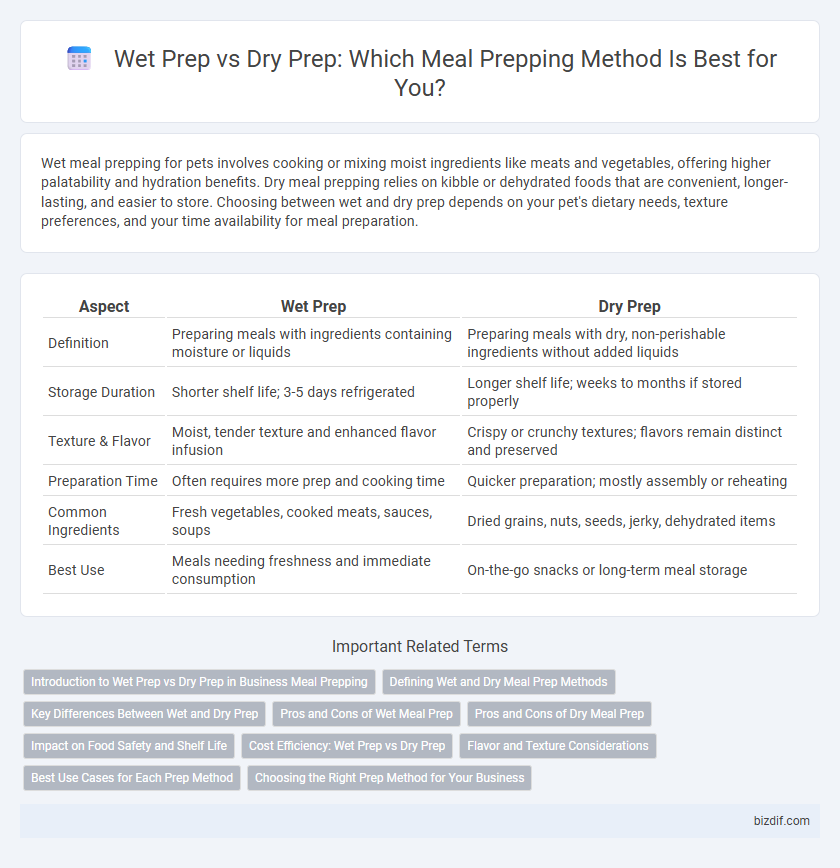Wet meal prepping for pets involves cooking or mixing moist ingredients like meats and vegetables, offering higher palatability and hydration benefits. Dry meal prepping relies on kibble or dehydrated foods that are convenient, longer-lasting, and easier to store. Choosing between wet and dry prep depends on your pet's dietary needs, texture preferences, and your time availability for meal preparation.
Table of Comparison
| Aspect | Wet Prep | Dry Prep |
|---|---|---|
| Definition | Preparing meals with ingredients containing moisture or liquids | Preparing meals with dry, non-perishable ingredients without added liquids |
| Storage Duration | Shorter shelf life; 3-5 days refrigerated | Longer shelf life; weeks to months if stored properly |
| Texture & Flavor | Moist, tender texture and enhanced flavor infusion | Crispy or crunchy textures; flavors remain distinct and preserved |
| Preparation Time | Often requires more prep and cooking time | Quicker preparation; mostly assembly or reheating |
| Common Ingredients | Fresh vegetables, cooked meats, sauces, soups | Dried grains, nuts, seeds, jerky, dehydrated items |
| Best Use | Meals needing freshness and immediate consumption | On-the-go snacks or long-term meal storage |
Introduction to Wet Prep vs Dry Prep in Business Meal Prepping
Wet prep in business meal prepping involves washing, peeling, chopping, and marinating ingredients, ensuring freshness and flavor infusion before cooking. Dry prep focuses on measuring, portioning, labeling, and organizing dry ingredients and tools, streamlining cooking operations and minimizing waste. Both methods optimize kitchen efficiency by reducing cooking time and enhancing meal consistency.
Defining Wet and Dry Meal Prep Methods
Wet meal prep involves preparing ingredients with added liquids such as sauces, broths, or marinades to enhance flavor and moisture retention, ideal for dishes like stews and soups. Dry meal prep focuses on assembling or cooking ingredients without added moisture, emphasizing roasted, grilled, or baked components that maintain texture and crispness. Both methods serve different culinary needs, optimizing meal freshness and taste based on the chosen preservation and reheating approach.
Key Differences Between Wet and Dry Prep
Wet prep involves handling ingredients with high moisture content such as marinating meats or washing vegetables, which requires sanitized surfaces to prevent cross-contamination. Dry prep focuses on chopping, slicing, and measuring dry ingredients like grains, spices, and nuts, emphasizing tools that avoid moisture absorption and clumping. Understanding these distinctions enhances meal prep efficiency and food safety by tailoring techniques and equipment to the specific ingredient types.
Pros and Cons of Wet Meal Prep
Wet meal prep offers the advantage of enhanced flavor and texture in dishes such as soups, stews, and marinated proteins, maintaining moisture during storage and reheating. However, wet prep can lead to shorter shelf life and increased risk of bacterial growth if not stored properly, requiring careful temperature control and airtight containers. The convenience of ready-to-eat meals is balanced by the potential mess and complexity involved in packaging liquids safely.
Pros and Cons of Dry Meal Prep
Dry meal prep offers the advantage of longer shelf life due to reduced moisture content, which helps prevent spoilage and mold growth. It also allows for easier portion control and minimizes the risk of sogginess, preserving texture and flavor in meals like grains, nuts, and dried fruits. However, dry prep foods often require additional cooking or hydration before consumption, which can add time and effort during meal assembly or reheating.
Impact on Food Safety and Shelf Life
Wet prep involves washing, chopping, and marinating ingredients, which can introduce moisture that accelerates bacterial growth if not properly refrigerated, thus reducing food safety and shortening shelf life. Dry prep, such as peeling and portioning without adding moisture, minimizes microbial risks and helps maintain longer freshness by limiting the conditions favorable for spoilage. Ensuring proper handling and storage temperatures is crucial in both wet and dry prep to maximize safety and extend the longevity of prepped meals.
Cost Efficiency: Wet Prep vs Dry Prep
Wet prep typically involves washing, chopping, and marinating ingredients in advance, which can reduce food waste and lower grocery costs by maximizing the use of perishable items. Dry prep focuses on organizing non-perishable components like grains, nuts, and spices, offering cost efficiency through bulk purchasing and longer shelf life. Choosing between wet and dry prep depends on balancing initial time investment with potential savings on food spoilage and purchase frequency.
Flavor and Texture Considerations
Wet prep enhances flavor by marinating ingredients, allowing spices and sauces to deeply penetrate proteins and vegetables, resulting in richer taste profiles. Dry prep preserves texture by maintaining crispness and firmness, ideal for salads or roasted dishes where moisture can dilute flavors or cause sogginess. Balancing wet and dry prep techniques optimizes meal prep, ensuring both vibrant flavors and appealing textures in ready-to-eat meals.
Best Use Cases for Each Prep Method
Wet prep excels in marinating proteins and softening vegetables, creating rich flavors and tender textures ideal for stews, soups, and slow-cooked meals. Dry prep is optimal for chopping, measuring, and portioning ingredients like grains, nuts, and dry spices, ensuring precise control in recipes such as salads, baking, and stir-fries. Choosing between wet and dry prep depends on the desired texture, moisture level, and recipe complexity, enhancing cooking efficiency and flavor development.
Choosing the Right Prep Method for Your Business
Selecting the appropriate meal prepping method--wet prep or dry prep--depends on your business model and menu requirements. Wet prep involves handling fresh, often perishable ingredients that require refrigeration, ideal for made-to-order or short shelf-life meals, while dry prep focuses on organizing non-perishable items for bulk cooking, enhancing efficiency and storage longevity. Analyzing factors like food safety regulations, customer demand, and inventory turnover helps optimize operational workflow and maximize profit margins.
Wet prep vs dry prep Infographic

 bizdif.com
bizdif.com